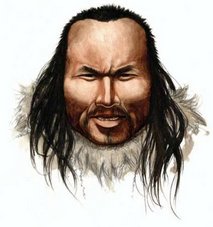WASHINGTON (Reuters) – Scientists have sequenced the DNA from four frozen hairs of a Greenlander who died 4,000 years ago in a study they say takes genetic technology into several new realms.
Surprisingly, the long-dead man appears to have originated in Siberia and is unrelated to modern Greenlanders, Morten Rasmussen of the University of Copenhagen and colleagues found.
 “This provides evidence for a migration from Siberia into the New World some 5,500 years ago, independent of that giving rise to the modern Native Americans and Inuit,” the researchers wrote in Thursday’s issue of the journal Nature.
“This provides evidence for a migration from Siberia into the New World some 5,500 years ago, independent of that giving rise to the modern Native Americans and Inuit,” the researchers wrote in Thursday’s issue of the journal Nature.
Not only can the findings help transform the study of archeology, but they can help answer questions about the origins of modern populations and disease, they said.
“Such studies have the potential to reconstruct not only our genetic and geographical origins, but also what our ancestors looked like,” David Lambert and Leon Huynen of Griffith University in Queensland, Australia, wrote in a commentary.
The DNA gives strong hints about the man, nicknamed Inuk. “Brown eyes, brown skin, he had shovel-form front teeth,” Eske Willerslev, who oversaw the study, told a telephone briefing. Such teeth are characteristic of East Asian and Native American populations.
He had the genes for early hair loss, too. “Because we found quite a lot of hair from this guy, we presume he actually died quite young,” Willerslev said.
The man lived among the Saqqaq people, the earliest known culture in southern Greenland that lasted from around 2500 BC until about 800 BC.
Scientists have disagreed on who these people were — whether they descended from the peoples who crossed the Bering Strait 30,000 to 40,000 years ago to settle the New World or whether they were more recent immigrants.
Willerslev’s team pulled DNA from hairs found in a frozen Saqqaq site and sequenced it just as they would a modern person’s full genome, looking for characteristic mutations.
“Recent advances in DNA sequencing technologies have initiated an era of personal genomics,” the researchers wrote.
“The sequencing project described here is a direct test of the extent to which ancient genomics can contribute knowledge about now-extinct cultures,” they added.
The DNA links Inuk to modern-day Arctic residents of Siberia. He had almost none of the mutations seen in Indians living in Central and South America.
“We have an increasingly powerful forensic tool with which to ‘reconstruct’ extinct humans and the demographics of populations,” Lambert and Huynen wrote.
A year ago scientists sequenced the genome of a Neanderthal — early humans who went extinct 30,000 years ago — and other groups have sequenced DNA from dried-out mammoth hair.
Did you know that if you subscribe to our website, you will receive email notifications whenever content changes or new content is added.
1. Enter your e-mail address below and click the Sign Me Up button.
2. You will receive an email asking you to confirm your intention of subscribing to our site.
3. Click the link in the email to confirm. That’s all there is to it! Note: if you wish to unsubscribe from our site, click the unsubscribe link at the bottom of the email you received.
Then indicate you no longer wish to receive our emails.
Thank You
Prisonbreakfreak.com Team